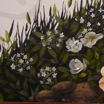Symbols

Many of the artefacts, flowers and other items depicted in the mural, are particular references, some of which are listed here. Clicking on the thumbnails brings up larger images.
The Coat-of-Arms of The Venerable English College in Rome
The Papal Secretariat of State granted the College its coat-of-arms in 1951. The arms of the two founders of the College are incorporated into the College blazon. The golden dragon is from the crest of Pope Gregory XIII and the small blue shield with three black hares is from the arms of Cardinal William Allen. The leopards represent the link with the English Monarchy and the scallop shell commemorates the medieval pilgrims. The motto translates as “I have come to bring fire to the Earth”
Flowers
The flowers betoken the brevity of earthly existence, sorrow, premature death and the fragility of life.
Plucked flowers
Flowers which are cut or plucked mark the early severance of a life in bloom.
Celandine
Enabling one to see, the Celandine heals spiritual blindness and brings light.
White Rose
Signifying purity of heart, the white rose is embroidered on Margaret Clitherow’s bodice as a reference to Margaret Clitherow’s informal title ‘The Pearl of York’.
Red Rose
The rose is the emblem of England and also represents perfection and beauty. In Catholic symbolism, the red rose is a symbol of Martyrdom.
Guelder Rose
Margaret Clitherow kneels amongst Guelder roses which are traditionally symbolic of the Holy Spirit. The stones beneath the roses allude to the stones upon which Saint Margaret was pressed to death.
Iris
The word ‘Iris' means 'sword lily' and implies the pain of the Virgin at the Passion of Christ. The natural colours of the Iris illustrate both the cold of winter and the warmth of spring, its petals the virtues of hope, faith and wisdom.
Anemone
The flower symbolises the Trinity, sorrow and death
Daffodil
The emblem for Wales, the daffodil also suggests the death of youth, resurrection and joy.
Lilies
Lilies in general characterise resurrection, honour and purity.
Lily of the Valley
Purity, one of the flowers that signals the return of spring. For this reason it has become a symbol of the Advent of Christ.
Passion flower
The classic Christian floral symbol of the Passion of Christ, which was first remarked by Jacomo Bosio in 1609 in Rome.
Plantain
A common plant found along roads and paths. It became known as 'way bread' and stood for those seeking the path to Christ.
Poppy
The poppy is associated with sleep, death, and the Passion of Christ because of its blood-red colour and the manner in which it appears in newly-disturbed ground.

The Riband
The text on the Riband, ‘Salvete flores martyrum’ ( Hail, flowers of the martyrs!), is a quote from the ‘Apostle of Rome’ Philip Neri’s salute to the English students of the Venerable English College in Rome. He was impressed by the cheerful nature of the students, all of whom might face a terrible martyrdom.



